2. 河北地质大学资源学院, 石家庄 050031;
3. 青岛海洋科学与技术试点国家实验室海洋矿产资源评价与探测技术功能实验室, 青岛 266237;
4. 山东省地质矿产勘查开发局第六地质大队, 威海 264209;
5. 成都理工大学地球科学学院, 成都 610059;
6. 山东省物化探勘查院, 济南 250013;
7. 山东省地质矿产勘查开发局, 济南 250013;
8. 中国科学院地球与行星物理重点实验室, 北京 100029
2. School of Resources, Hebei GEO University, Shijiazhuang 050031, China;
3. Laboratory for Marine Mineral Resources, Qingdao National Laboratory for Marine Science and Technology, Qingdao 266237, China;
4. Shandong Provincial No.6 Exploration Institute of Geology and Mineral Resources, Weihai 264209, China;
5. College of Earth Sciences, Chengdu University of Technology, Chengdu 610059, China;
6. Shandong Institute of Geophysical and Geochemical Exploration, Jinan 250013, China;
7. Shandong Bureau of Geology and Mineral Resources Exploration and Development, Jinan 250013, China;
8. Key Laboratory of Earth and Planetary Physics, Chinese Academy of Sciences, Beijing 100029, China
胶东是举世瞩目的金矿集区,累计探明黄金资源储量超过5000t(宋明春等,2018)。胶东金矿主要可分为蚀变岩型和石英脉型两种矿床类型。蚀变岩型金矿主要是指赋存于大型断裂带内以发育含金黄铁绢英岩化蚀变为特征的金矿,又被称为“焦家式”金矿;石英脉型金矿主要是指金赋存于中生代花岗岩中的热液石英脉中的金矿类型,通常又称之为“玲珑式”金矿。蚀变岩型和石英脉型金矿也是华北克拉通周缘金矿的主要矿床类型(朱日祥等,2015)。目前,胶东已探明的“焦家式”金矿资源量超过4100t,占全部已探明资源量的80%以上。近年来,胶东深部找矿取得重大突破,经过系统勘查发现受焦家断裂带控制的浅部矿床(体)(如焦家、马塘、寺庄等)在深部(对应的为焦家深部、朱郭李家、纱岭等)连接成一体或平行斜列,构成了一个千吨级的超巨型金矿床,其资源量超过1500t(宋明春,2015;于学峰等,2016)。前人主要根据焦家金矿床浅部(-500m标高以浅)微量元素、S-H-O同位素以及流体包裹体等来探讨成矿物质来源及矿床成因(张连昌等,2002;毛景文等,2005),提出了成矿流体来源于岩浆水、大气降水、变质水以及地幔等认识(Hu et al., 2006;Shen et al., 2013;Li and Santosh, 2014;郭林楠等,2014;杨立强等,2014)。宋明春等(2013)对焦家深部金矿床钻孔岩心作了主微量、同位素和包裹体研究,发现蚀变岩型金矿与石英脉型金矿的稳定同位素和流体包裹体地球化学特征有很大差异,认为二者形成于不同的成矿条件,早白垩世伟德山花岗岩岩浆活动所引起的流体活化是导致金矿成矿的直接原因,对焦家金矿床深部流体来源及演化仍未取得突破性进展。成矿流体性质究竟如何,成为当前胶东金矿成因机制研究中亟待解决的关键问题之一。因此,深入研究焦家金矿成矿流体性质、来源以及成矿机制具有重要的理论价值和实际意义。
近年来,利用LA-ICP-MS、SIMS、Nano-SIMS等微区原位分析技术分析黄铁矿中微量元素及硫同位素组成,揭示了靠传统分析方法不能获得的有关金矿成矿流体性质、来源和成矿过程的信息(Large et al., 2009, 2011;Liang et al., 2014;Yuan et al., 2018;Zhao et al., 2018)。目前,黄铁矿微量元素结合硫同位素示踪已成为了探讨金矿成矿机制的有利地球化学工具(Norman et al., 1989;Ghazi et al., 1993;Banks et al., 1994;李厚民等,2003;单强等,2009;陈炳翰等,2014)。同时,黄铁矿中的惰性气体同位素(如He、Ar等)示踪也为成矿物质来源提供了有利约束(Stuart et al., 1995;Hu et al., 2004;Sun et al., 2004;毛景文和李晓峰,2004;孙景贵等,2007;张运强等,2012;薛建玲等,2013;丁德建等,2014)。
在前人研究基础上,本文选择焦家金矿床深部I号主矿体不同钻孔进行了系统取样,开展了黄铁矿微量元素、S-He-Ar同位素组成研究,示踪了成矿流体来源及演化过程。
1 成矿地质背景胶东地区处于华北克拉通东南缘和大别-苏鲁造山带东端的结合部位,前者由胶北隆起和胶莱盆地构成,后者为威海超高压带(Zhao et al., 2005;Li et al., 2010, 2011;宋明春等,2013;Song et al., 2015)。胶北隆起主要由前寒武纪变质基底和中生代花岗岩类组成,胶莱盆地由中生代白垩纪陆相火山-沉积岩系组成,威海超高压带主要由新元古代含榴辉岩的花岗质片麻岩、中生代侵入岩及火山沉积岩组成(图 1a)。
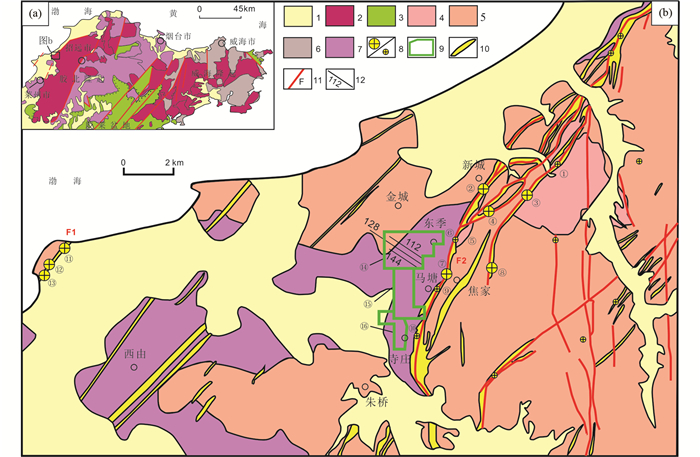
|
图 1 焦家地区金矿床地质简图(据宋明春等,2013修改) 1-第四系;2-中生代花岗岩类;3-中生代火山沉积岩;4-白垩纪郭家岭花岗岩;5-侏罗纪玲珑花岗岩;6-新元古代含榴辉岩的花岗质片麻岩;7-新太古代变质岩系(变辉长岩);8-浅部金矿位置;9-深部金矿范围;10-构造蚀变带;11-断裂;12-采集样品的勘探线位置及编号. F1-三山岛断裂;F2-焦家断裂. ①上庄金矿;②新城金矿;③河东金矿;④河西金矿;⑤龙埠金矿;⑥东季金矿;⑦焦家金矿;⑧望儿山金矿;⑨马塘金矿;⑩寺庄金矿;B11三山岛金矿;B12新立金矿;B13仓上金矿;B14焦家深部金矿;B15朱郭李家金矿;B16纱岭金矿 Fig. 1 The Geological sketch map of the Jiaojia gold field (modified after Song et al., 2013) 1-Quaternary; 2-Mesozoic granites; 3-Mesozoic volcanic sedimentary rocks; ; 4-Cretaceous Guojialing granite; 5-Jurassic Linglong granite; 6-Neoproterozoic granitic gneiss, which contains eclogite; 7-Neoarchean metamorphic complex (metamorphic gabbro); 8-position of shallow gold deposit; 9-range of deeply-seated gold deposit; 10-beresitization alteration zone; 11-faults; 12-sampling exploration lines and number. F1-the Sanshandao fault; F2-the Jiaojia fault. ① the Shangzhuang gold deposit; ② the Xincheng gold deposit; ③ the Hedong gold deposit; ④ the Hexi gold deposit; ⑤ the Longbu gold deposit; ⑥ the Dongji gold deposit; ⑦ the Jiaojia gold deposit; ⑧ the Wangershan gold deposit; ⑨ the Matang gold deposit; ⑩ the Sizhuang gold deposit; B11 the Sanshandao gold deposit; B12 the Xinli gold deposit; B13 the Cangshang gold deposit; B14 the Jiaojia deeply-seated gold deposit; B15 the Zhuguolijia gold deposit; B16 the Shaling gold deposit |
焦家金矿床位于胶北隆起区,区内主体岩性为中生代花岗岩及新太古代变质岩,大多被第四系覆盖。以焦家断裂为界,东侧为中生代玲珑二长花岗岩和郭家岭花岗闪长岩,西侧为新太古代变辉长岩(图 1b)。新太古代变质岩由TTG岩系、变辉长岩和少量胶东岩群组成;中生代花岗岩主体为侏罗纪玲珑花岗岩,有少量白垩纪郭家岭花岗岩,发育伟晶岩、细晶岩、闪长玢岩、辉绿玢岩和煌斑岩等脉岩。区域主要控矿构造为NE向焦家断裂带和三山岛断裂带,焦家断裂带控制了焦家、马塘、纱岭、新城、寺庄等大型-特大型金矿床;焦家断裂下盘与之近平行产出的次级断裂(如望儿山、灵山沟-北截、河西、侯家、邱家断裂等)控制了望儿山、河西等大型金矿床。焦家断裂走向长约20km(焦家矿区内出露长度1.9km),宽100~500m,呈舒缓波状S形展布,平均走向约30°,倾向NW,倾角上陡下缓,近地表倾角60°~70°,深部倾角16°~40°。断裂在地表大致沿新太古代变质岩与侏罗纪玲珑花岗岩的接触带分布,深部则穿切玲珑花岗岩或郭家岭花岗岩。
2 矿床地质特征焦家深部金矿床共圈定4个矿体群,包括99个矿体,其中I号矿体延伸稳定,规模最大,资源量约占总储量的90%。矿体走向长580~1160m,斜深790~2470m,最大控制垂深1120m,矿体呈似层状、大脉状产出,具分枝复合等特点;矿体产状与控矿的焦家断裂基本一致,走向约为30°,倾向NW,倾角16°~30°;厚度1~38m,品位1.01×10-6~11.97×10-6(李杰,2012),矿体在倾角由陡变缓部位变大变厚,形成了“富矿台阶”。其他矿体大多位于I号矿体之下,或与之平行、或沿陡倾裂隙发育(图 2)。
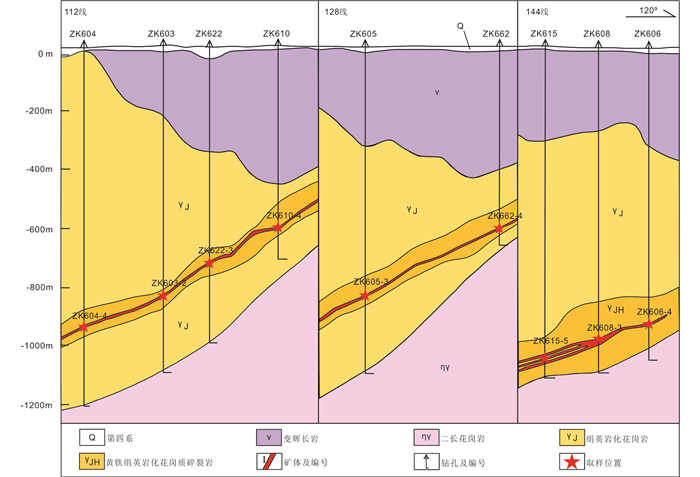
|
图 2 焦家深部金矿床典型勘探线剖面图 Fig. 2 Geological section of typical exploration line in the Jiaojia deeply-seated gold deposit |
焦家深部金矿床矿石呈灰白色、灰色、淡肉红色(对应不同的矿化类型),碎裂、碎斑结构,浸染状、斑杂状构造。矿石中主要金属矿物为自然金和黄铁矿,其次为黄铜矿、方铅矿、闪锌矿,见少量磁黄铁矿;主要非金属矿物为石英、绢云母、长石等。围岩蚀变类型主要有钾长石化(红化)、黄铁绢英岩化、硅化和碳酸盐化等,呈现出蚀变作用持续时间长、各种蚀变作用相互叠加、蚀变分带明显的特点(宋明春等, 2010, 2011a, b;李杰,2012)。矿石自然类型主要有细粒浸染状黄铁绢英岩化碎裂岩型、浸染状-细脉状-脉状黄铁绢英岩化花岗质碎裂岩型、细脉-网脉状黄铁绢英岩化花岗岩型等三种类型(图 3a-e);矿石工业类型为低硫型金矿石。根据控矿构造与矿体的关系、矿化蚀变与金品位关系等,将热液成矿期划分为四个阶段:黄铁矿-石英阶段(ⅰ)、金-石英-黄铁矿阶段(ⅱ)、金-石英-多金属硫化物阶段(ⅲ)和石英-碳酸盐阶段(ⅳ),其中第ⅱ、ⅲ阶段是金的主要成矿阶段。
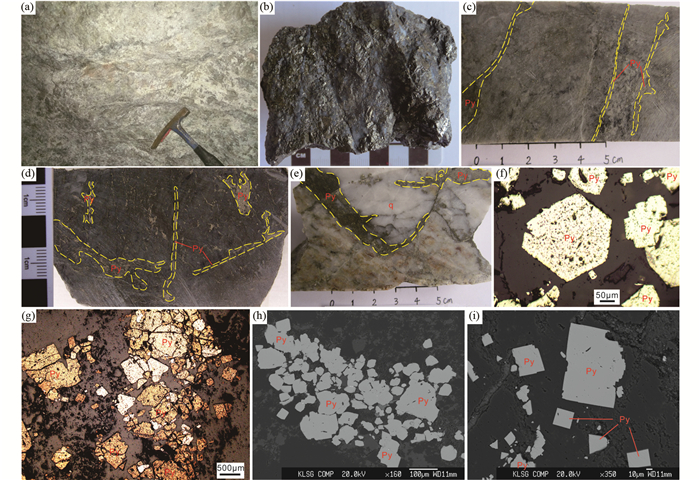
|
图 3 焦家深部金矿床矿化特征 (a、b)硅化、黄铁绢英岩化碎裂岩;(c)细脉状黄铁绢英岩化碎裂岩;(d)浸染状黄铁绢英岩化碎裂岩;(e)黄铁矿化花岗岩夹石英脉;(f、g)黄铁矿呈自形(五角十二面体)-半自形产出,局部发育裂隙(反射光照片);(h、i)黄铁矿呈自形(立方体)-半自形产出,未见明显环带结构(背散射照片) Fig. 3 Mineralization characteristics of the Jiaojia deeply-seated gold deposit (a, b) pyrite sericitized cataclastic rocks with silicification; (c) veinlet pyrite sericitized cataclastic rocks; (d) disseminated pyrite sericitized cataclastic rocks; (e) pyritized granite with quartz veins; (f, g) pyrite occurs in euhedral-granular texture (pentagonal dodecahedron) and hypidiomorphic-granular texture with local fissures (reflected); (h, i) pyrite occurs in euhedral-granular texture (cube) and hypidiomorphic-granular texture, no obvious zonal structure was found (BSE) |
黄铁矿是矿石中最主要的金属矿物,含量一般为5%左右,最高达10%。黄铁矿是主要的载金矿物,其含量与金品位呈正相关关系。矿石中的黄铁矿呈浅黄色,强金属光泽,自形-半自形晶粒状或不规则粒状结构,立方体和五角十二面体晶形均有发育,呈稀疏或稠密浸染状分布于脉石矿物中,或呈脉状填充于裂隙中(图 3c-e),粒度一般在0.01~2mm之间,大者可达5mm以上。镜下观察发现,不同成矿阶段的黄铁矿存在差异:金-石英-黄铁矿阶段(ⅱ)的黄铁矿多呈不规则粒状,浅黄色,强金属光泽,具裂纹但不发育,粒度较粗者常与石英呈脉状集合体分布(图 3f,g);金-石英-多金属硫化物阶段(ⅲ)中的黄铁矿以细粒自形晶为主,灰黄色,光泽暗,常与黄铜矿、方铅矿、闪锌矿等多金属硫化物共生,呈细脉状、网脉状分布。对黄铁矿进行背散射电子扫描成像(BSE)和电子探针分析发现,不同晶形和不同期次黄铁矿的成分较为均一、结构简单(未见环带生长结构)(图 3h,i),反映出形成环境的一致性,是一次成矿事件的产物。
3 样品采集和分析方法本次研究选择焦家深部金矿床I号主矿体,系统采集了112、128、144勘探线上9个钻孔中-602~-1050m深度的矿石样品(图 2),在进行详细野外和室内岩相学观察的基础上,挑选了主成矿期(第ii成矿阶段)黄铁矿单矿物进行测试分析。用于测试的黄铁矿呈浅黄色,强金属光泽,自形-半自形粒状结构,粒度50~1000μm,呈浸染状、细脉状分布于黄铁绢英岩化碎裂岩中。黄铁矿微量元素和S同位素分析在核工业北京地质研究院分析测试中心完成,黄铁矿He-Ar同位素组成分析在中国科学院地质与地球物理研究所稀有气体实验室完成。
黄铁矿微量元素(包括稀土元素)分析采用ICP-MS法,仪器型号为Element Ⅰ。主要实验条件:仪器功率1400W,冷却气16L/min,辅助气1.21L/min,雾化气流速0.852L/min,进样泵速20r/min,进样冲洗时间50s,单个元素积分时间0.001s,各元素的检出限为0.002×10-6。详细分析流程见参考文献(陈炳翰等,2014)。S同位素分析样品以Cu2O作为氧化剂制样,在1000℃真空条件下反应15分钟,将S氧化为SO2,测试SO2的硫同位素组成。所用质谱仪型号为Finnigan MAT-251,以VCDT为标准,测试精度为±0.2‰。
先将挑纯后的黄铁矿用5%的稀HNO3超声波清洗以去除可能的蚀变影响以及颗粒表面放射性成因和宇宙射线成因的元素影响(Moreira and Madureira, 2005),然后用去离子水超声波清洗干净,并用丙酮清洗、烘干,准确称量样品装载到真空粉碎器中在Noblesse稀有气体质谱仪上进行He、Ar同位素测量。通常通过约1500psi的压力单次静压样品以释放气体,释放出的气体依次通过液氮温度下的不锈钢冷阱去除一些高熔沸点的气体(H2O等)、四个锆铝泵(两组,每组中一个室温,另一个约200℃)去除一些活性气体,利用液氮温度下的装有活性炭的不锈钢冷阱可以吸附Ar以完成He和Ar的分离。详细实验流程参见文献(He et al., 2011;苏菲等,2014)。该仪器的大于700的质量分辨率足以将3He和HD分开,实验观测证明,当3He的计数大于1cps时,HD的影响基本上不存在,故以此作为筛选数据的依据之一。样品数据结果是以空气作为标样计算得到。假设所测量气体是来源于压碎后小于100目的样品,在实验结束后将所装样品过筛,称取小于100目(75μm)的样品重量作为样品重量来计算稀有气体的含量(Burnard et al., 1999)。
4 测试结果 4.1 黄铁矿微量元素组成焦家金矿床I号主矿体黄铁矿稀土、微量元素含量及特征参数如表 1所示。黄铁矿稀土总量介于3.27×10-6~38.5×10-6之间,平均值为14.6×10-6;LREE/HREE介于5.28~31.6之间;(La/Yb)N值介于7.86~130之间;δEu值介于0.67~1.43之间;δCe值介于0.81~1.05之间。特征元素对比值Co/Ni介于0.54~1.57之间,Hf/Sm介于0.22~2.68之间,Nb/La介于0.01~0.95之间,Th/La介于0.09~0.74之间,Y/Ho介于21.9~35.5之间,Zr/Hf介于9.44~37.7之间,Nb/Ta介于1.40~23.8之间。
|
|
表 1 焦家深部金矿床黄铁矿稀土、微量元素含量(×10-6)及特征参数表 Table 1 Contents (×10-6) and characteristic parameters of trace elements of pyrite in the Jiaojia deeply-seated gold deposit |
黄铁矿S同位素组成如表 2所示。δ34SCDT值介于7.5‰~9.8‰之间,平均值为8.7‰。
|
|
表 2 焦家深部金矿床I号主矿体黄铁矿硫同位素组成 Table 2 Sulfur isotopic compositions of pyrite in No. I orebodies of the Jiaojia deeply-seated gold deposit |
焦家深部金矿床矿石的黄铁矿流体包裹体中He、Ar同位素组成及比值如表 3所示。3He含量介于4.9×10-14~13.3×10-14 ccSTP/g,4He含量介于2.8×10-7~8.2×10-7 ccSTP/g,40Ar含量介于4.0×10-7~14.3×10-7 ccSTP/g,40Ar*含量介于2.7×10-7~12.9×10-7 ccSTP/g。3He/4He比值为1.6±0.1Ra~1.8±0.1Ra(Ra代表大气氦3He/4He=1.4×10-6),相应的R/Ra变化范围为1.61~1.73,40Ar/36Ar比值为750.4±11.4~3106.7±487.0,40Ar*/4He比值为0.65~1.56,38Ar/36Ar比值为0.185±0.002~0.197±0.026。
|
|
表 3 焦家深部金矿床黄铁矿He-Ar同位素含量及比值 Table 3 Helium and argon isotopic compositions and ratios of pyrites in the Jiaojia deeply-seated gold deposit |
由于稀土元素(REE)和高场强元素(HFSE)很难类质同象代替黄铁矿中的Fe2+,它们在黄铁矿中最可能的赋存方式是存在于流体包裹体或晶体缺陷中,其含量受晶体结构的影响不大,因此,黄铁矿微量元素组成和特征代表了成矿流体中微量元素的基本特征(毕献武等,2004)。稀土元素在溶液中可与卤族元素、碳酸根、硫酸根等结合,形成氯化物、氟化物、硫酸盐、碳酸盐或复杂络合物等(韩吟文等,2003).
焦家金矿床I号主矿体黄铁矿稀土含量整体较低(ΣREE为3.27×10-6~38.48×10-6),轻、重稀土元素具有较大的分馏(LREE/HREE为5.28~31.55,(La/Yb)N为7.86~130.0)(表 1)。黄铁矿稀土配分曲线呈右倾型(图 4a),富集LREE,表明成矿流体这含有大量的Cl-或F-(Haas et al., 1995;Keppler,1996;毕献武等,2004)。研究表明,富Cl的热液中Hf/Sm、Th/La、Nb/La比值一般小于1;富F的热液中Hf/Sm、Th/La、Nb/La比值一般大于1,且富集HFSE(Oreskes and Einaudi, 1990)。焦家金矿床黄铁矿微量元素中亏损HFSE,相对富集Cu、Pb、Zn、Cd、Co、Ni等亲硫、亲铁元素(图 4b),Th/La、Nb/La比值均小于1,表明成矿流体为富Cl流体。
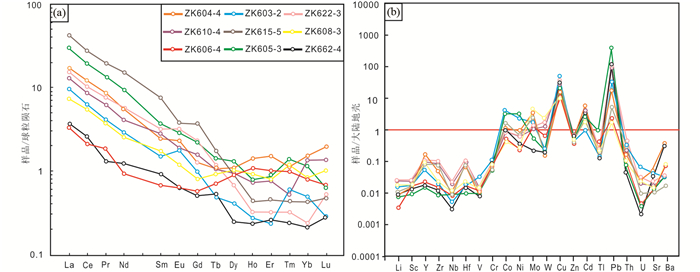
|
图 4 黄铁矿球粒陨石标准化稀土元素分布型式图(a, 标准化值据Sun and McDonough, 1989)及大陆地壳标标准化微量元素蛛网图(b, 标准化值据Rudnick and Gao, 2003) Fig. 4 Chondrite-normalized REE patterns (a, normalization values after Sun and McDonough, 1989) and continental crust-normalized trace element spider diagrams (b, normalization values after Rudnick and Gao, 2003) of pyrite |
Ce和Eu是稀土元素中的变价元素,氧化条件下,Ce3+被氧化为Ce4+,与其他稀土元素分离而呈现出Ce异常,可用来反映体系的氧化还原环境。焦家深部金矿黄铁矿δCe值变化范围较小(0.81~1.05),整体显示无明显异常(图 4a),表明在金成矿体系处于相对还原的物理化学环境,这与前人对该区域金成矿流体的研究结论一致(陈炳翰等,2014;郭林楠等,2019)。在高温还原性热液中,Eu3+易于还原为Eu2+脱离热液体系进入矿物相,使矿物中呈现出Eu正异常;对应的低温还原性环境下,矿物中则容易产生Eu负异常(陈炳翰等,2014)。焦家深部金矿黄铁矿δEu值变化范围较大(0.67~1.43),表明成矿温度变化范围较大,这与石英流体包裹体测温的结果一致(温度变化范围介于360~128℃之间,主要集中在340~270℃)(宋明春等,2013)。
黄铁矿中的微量元素Co和Ni等呈类质同象取代Fe,Co与Fe的地球化学性质更相似,故Co比Ni更易进入黄铁矿晶格,因此黄铁矿中的Co/Ni比值对成矿条件具有一定的指示意义(Brill,1989)。黄铁矿的Co/Ni比值还可以用来指示矿物的形成温度(胡瑛等,2009),一般Co/Ni值越小,矿物的形成温度越低(盛继福等,1999)。研究表明,沉积成因的黄铁矿Co/Ni比值通常小于1,平均为0.63;热液成因的黄铁矿Co/Ni比值平均值约为1.7,且一般小于5;与火山成因有关的黄铁矿Co/Ni比值通常大于5,典型的在5~50之间(Bralia et al., 1979)。焦家深部金矿床黄铁矿Co/Ni比值介于0.54~1.57之间,平均为0.99,说明其与火山成因无关,同时说明成矿温度整体为中低温,这与δEu值指示的成矿温度一致。在图 5中,焦家深部金矿床黄铁矿落在沉积成因、热液成因区的左下方,与焦家金矿石全岩投点规律相似,均位于Co/Ni=1的线附近。对比区域上的金矿床发现:台上金矿床黄铁矿投点落在沉积成因区及外围附近,Co、Ni含量及Co/Ni比值变化均较大;罗山金矿床黄铁矿投点落在沉积和热液成因区及外围附近;金翅岭金矿床黄铁矿投点均位于沉积成因、热液成因区的左下方,变化范围较大。整体而言,胶东金矿床黄铁矿Co、Ni含量偏低,Co/Ni比值变化范围大,在Co-Ni关系图上投点除少数落在沉积成因和热液成因区内,大部分投点均位于其左下方,表明黄铁矿成因与热液作用和沉积作用有关。胶东地区整体缺失中生代沉积地层,推测载金黄铁矿应为热液成因。大部分投点偏离热液成因区的原因可能是成矿过程经历了不同形式的热液演化或有不同的流体混入,投到沉积成因区的黄铁矿可能为区域变质基底中残留的沉积成因黄铁矿。
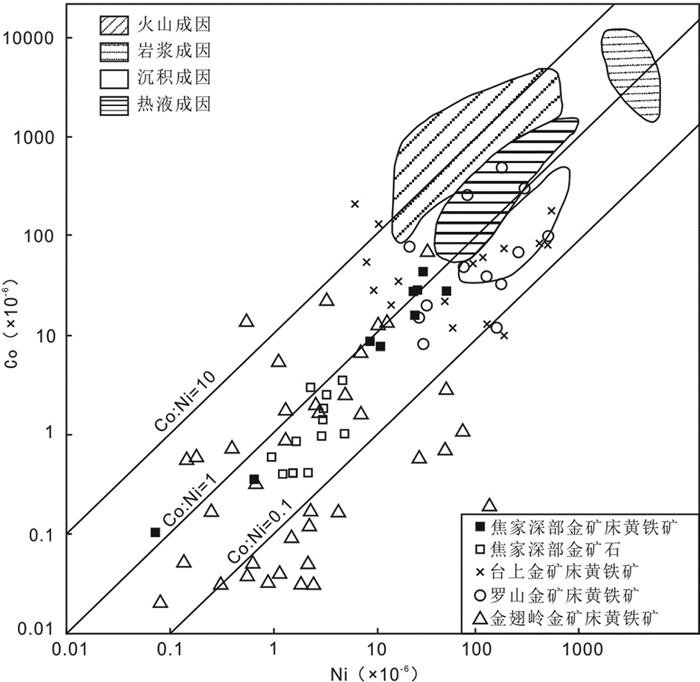
|
图 5 焦家深部金矿床黄铁矿Co-Ni分布图(底图据Bajwah et al., 1987;Brill, 1989) 焦家深部金矿床黄铁矿数据为本文测得.其他数据来自:宋明春等,2013;陈炳翰等,2014;郭林楠等,2019;朱照先等,2019 Fig. 5 Co vs. Ni distribution diagram of pyrites from the Jiaojia deeply-seated gold deposit (base map modified after Bajwah et al., 1987; Brill, 1989) |
胶东金矿成矿热液流体性质一直存在争议,争论的焦点在于成矿流体是岩浆流体还是变质流体(陈衍景等,2004;毛景文等,2005;宋明春等,2013;杨立强等,2014)。从焦家金矿床黄铁矿Co、Ni含量分布情况(图 5)看,其明显低于岩浆流体中的含量,而与变质热液型金矿中的平均含量相近(郭林楠等,2019),Co/Ni比值明显低于岩浆热液型金矿(Co/Ni=8.16)而略高于变质热液型金矿(Co/Ni=0.60)(Yan et al., 2014)。可见焦家金矿成矿流体与变质流体相近,这可能与板片俯冲及后撤过程中脱水形成的流体有关。
Y-Ho、Zr-Hf和Nb-Ta这三组元素对分别具有相近的离子半径和电价,Y/Ho、Zr/Hf和Nb/Ta值在同一热液体系中比值稳定,但当体系受热液活动或交代作用影响时,这些元素对比值则会有较大的变化范围(Bau and Dulski, 1995;Yaxley et al., 1998)。焦家深部金矿黄铁矿Y/Ho、Zr/Hf和Nb/Ta值变化范围较大(分别为:21.93~35.46、9.44~37.67、1.40~17.57),表明成矿热液体系可能发生了交代作用或有多期次热液活动叠加。其中Y/Ho值(21.93~35.46)与地幔值(25~30)和中国东部大陆地壳值(20~35)接近,指示成矿流体与地壳和地幔均有一定的渊源。
上述研究表明,焦家深部金矿床的成矿流体稀土元素总量较低,富集轻稀土元素,亏损高场强元素,温度范围变化较大,为还原性流体,成矿热液体系可能发生了交代作用或有多期次热液活动叠加。
5.2 成矿流体同位素示踪 5.2.1 S同位素焦家深部金矿床黄铁矿的δ34SCDT介于7.5‰~9.8‰之间(表 2),平均值为8.7‰,极差2.3‰,说明硫均一化程度高,整体具有一致的来源,且呈现出富集34S的特征。焦家浅部金矿床δ34S介于8.7‰~11.8‰之间,平均值为10.1‰(李俊健,2006),本次测得的深部金矿床硫同位素组成整体低于浅部金矿床,也低于宋明春等(2013)的测试结果(δ34S介于11.1‰~12.6‰之间,平均值为11.4‰)。前人已经注意到胶西北地区金矿床δ34S值呈现出自东向西递增的规律(王义文等,2002)和从石英脉型到蚀变岩型金矿更加富集34S的特点(毛景文等,2005)。本文对胶东地区不同空间位置(胶西北成矿区、牟乳成矿区、栖蓬福成矿区以及胶莱盆地周缘)、不同矿化类型(蚀变岩型、石英脉型、硫化物石英脉型、蚀变角砾岩及砾岩型等)、不同深度(矿床浅部与深部)的典型金矿床黄铁矿硫同位素组成(表 4、图 6)研究发现:胶东金矿硫同位素组成整体一致,除极少数矿床34S值呈现出个别负值外,绝大多数34S值均为正值,变化范围主要集中在6‰~12‰。整体而言,δ34S值呈现出:石英脉型<硫化物石英脉型<蚀变岩型(包括破碎带蚀变岩型、蚀变砾岩型和蚀变角砾岩型)的变化规律。空间上,栖蓬福成矿区的金矿床δ34S值最低,其次为牟乳成矿区,胶莱盆地东北缘较胶西北成矿区金矿床的δ34S值略高,胶西北成矿区自西向东δ34S值整体呈减小的趋势,与这一规律相对应的是这些地区金矿的矿化类型的差异,栖蓬福成矿区的金矿类型主要为石英脉型,牟乳成矿区的金矿类型主要为硫化物石英脉型,胶西北成矿区西部金矿主要为蚀变岩型而东部则为石英脉型。可见,造成硫同位素组成差异最大的因素是金矿类型的不同。在垂向上,已取得深部找矿突破的矿床均呈现出由浅到深δ34S值整体呈减小的趋势(图 6)。有学者认为造成这一现象的原因是石英脉型金矿成矿流体来源较深,代表了成矿原始流体系统的硫同位素组成,而蚀变岩型金矿成矿流体在成矿时与围岩中的硫发生了同位素交换,混入了较多的表生硫,导致δ34S值增高(毛景文等,2005;宋明春等,2013)。综合分析胶东金矿硫同位素特征及成矿背景,本文认为胶东金矿床中的硫是与古老的变质基底岩系、中生代花岗岩以及幔源流体具有继承演化关系的混合硫。焦家深部金矿床δ34S值整体较浅部低,说明深部成矿物质受近地表围岩的混染程度降低或者有更多的幔源物质加入。
|
|
表 4 胶东地区典型金矿床硫同位素组成 Table 4 Sulfur isotopic compositions of typical gold deposits in Jiaodong area |
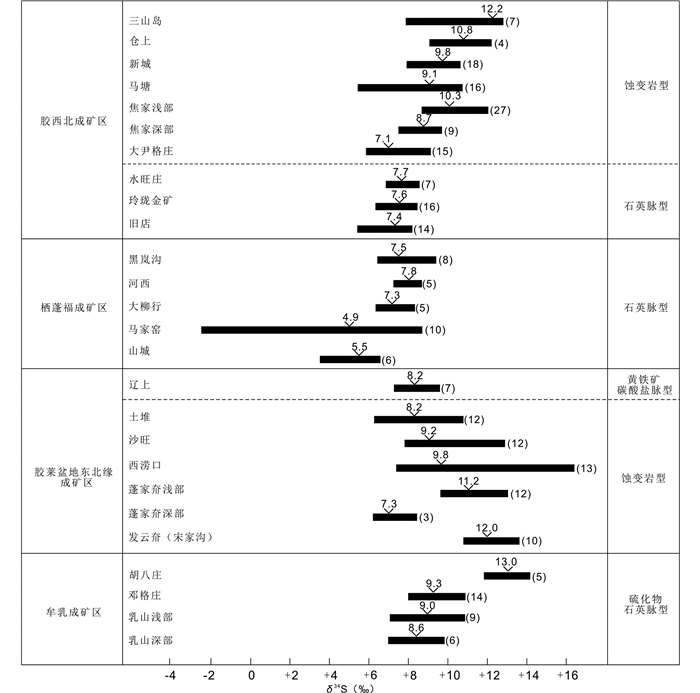
|
图 6 胶东地区典型金矿床硫同位素组成 Fig. 6 Diagram showing sulfur isotopic compositions of typical gold deposits in Jiaodong area |
焦家深部金矿床黄铁矿流体包裹体中的3He/4He值为1.6~1.8Ra,与前人测得焦家浅部金矿床数据基本一致(张连昌等,2002),这一数值远高于大陆地壳流体特征值(0.01~0.05Ra)(Stuart et al., 1994, 1995),而低于地幔特征值(6~9Ra)(Dunai and Porcelli, 2002),表现为地幔与地壳混合组成的特点。在3He-4He图解上(图 7),投点位于地壳与地幔组成的过渡带,且呈现出由地幔氦向地壳氦演化的趋势。根据壳-幔混合二元模型(Stuart et al., 1995),计算的焦家深部金矿床黄铁矿中幔源He所占比例为20.6%~22.2%(表 3),说明有较多的幔源流体参与了成矿过程。
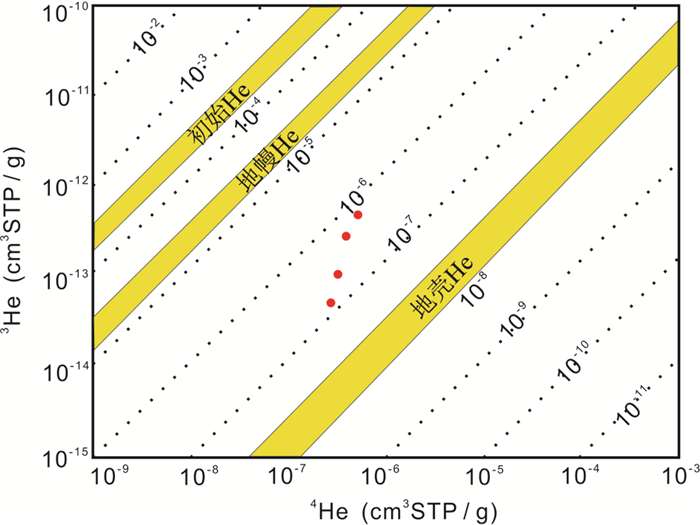
|
图 7 焦家深部金矿床黄铁矿流体包裹体3He-4He图(据Mamyrin and Tolstikhin, 1984修改) Fig. 7 3He vs. 4He diagram of fluid inclusions from the Jiaojia deeply-seated gold deposit (after Mamyrin and Tolstikhin, 1984) |
在4He含量与3He/4He比值图解中(图 8),投点落在地壳流体范围和大陆岩石圈地幔流体范围之间,黄铁矿中4He含量(2.8×10-7~8.2×10-7 ccSTP/g)较高,显示该矿床的矿物流体包裹体中含有较高的放射成因4He(Gautheron et al., 2005)。
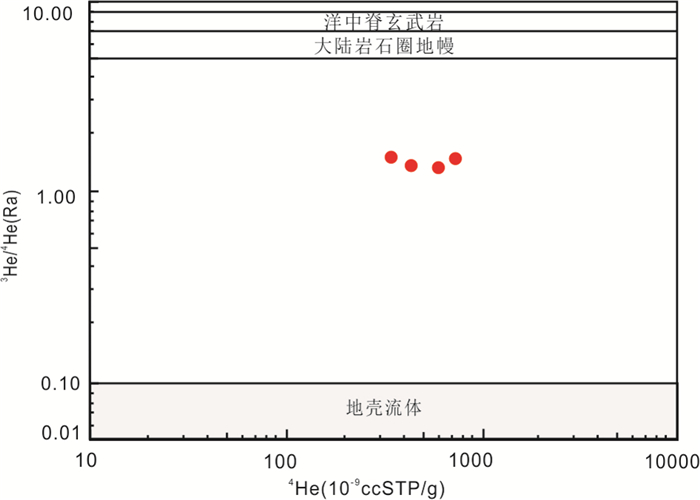
|
图 8 焦家深部金矿床黄铁矿4He含量与3He/4He比值关系图(据Gautheron et al., 2005) Fig. 8 4He vs. 3He/ 4He diagram of fluid inclusions from the Jiaojia deeply-seated gold deposit (after Gautheron et al., 2005) |
焦家深部金矿床黄铁矿中的40Ar/36Ar比值为750.4~3106.7,均高于饱和大气水(295.5)和古老地壳流体的特征值(295.6),但又明显低于地幔流体特征值(>40000)(Allègre et al., 1987;王先彬等,1996;Kaneoka,1998),同样显示出混合来源特征。根据Kendrick et al.(2001)计算的黄铁矿中放射性成因40Ar(40Ar*)所占比例为60.62%~90.49%,相应大气Ar所占比例为9.51%~39.38%,说明成矿流体中有一定的大气水混入,且表现出随着深度增加大气Ar所占比例呈明显减小的趋势(表 3、图 9)。
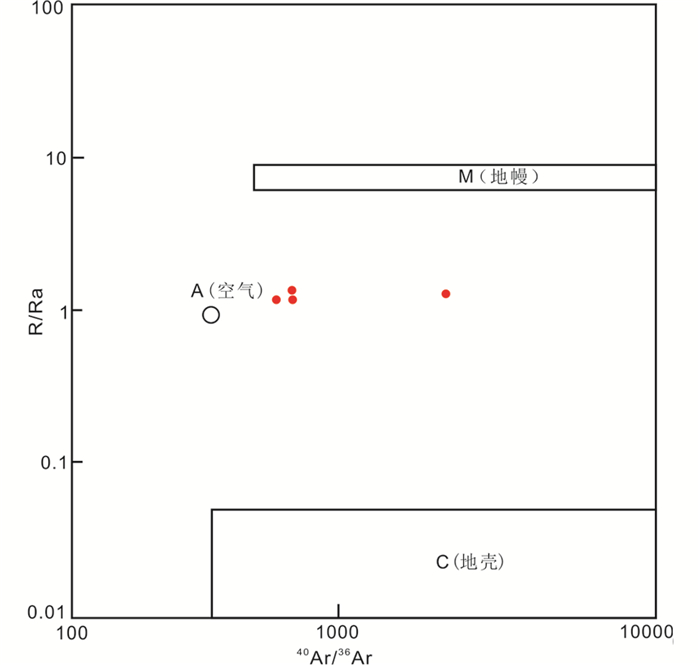
|
图 9 焦家深部金矿床黄铁矿40Ar/36Ar-R/Ra图(据Winckler et al., 2001) Fig. 9 40Ar/36Ar vs. R/Ra diagram of fluid inclusions from the Jiaojia deeply-seated gold deposit (after Winckler et al., 2001) |
地球系统的流体源主要为地幔/软流圈、地壳和大气来源(Matsumoto et al., 2001;Gautheron and Moreira, 2002;Trieloff et al., 2002; Buikin et al., 2005),但大多数矿床的流体往往不具有上述典型流体源特征,而是显示出混合型流体性质(Turner and Stuart, 1992;毛景文和李晓峰,2004;孙晓明等,2006)。本文的研究同样表明,焦家深部金矿床的成矿流体不具单一来源流体特征,而是地壳和地幔的混合流体,有较多的幔源流体参与了成矿过程,指示金成矿与壳-幔相互作用有关。
中生代,中国东部岩石圈大规模减薄(邓晋福等,1999),华北克拉通破坏、强烈壳幔相互作用、地壳拆沉,在这种构造背景下,在短时间内集中爆发形成了一系列与克拉通破坏有关的金矿(朱日祥等,2015),深部流体在向上运移的过程中与地壳流体相互作用造成金元素巨量聚集成矿。
6 结论(1) 焦家深部金矿床黄铁矿稀土含量较低,富集轻稀土元素和Cu、Pb、Cd、Zn、Co、Ni等亲硫、铁族元素,亏损高场强元素,为富Cl、中高温-中低温还原性流体,具有多期次交代作用或热液活动叠加的特点。Co/Ni比值介于0.54~1.57之间,平均为0.99,表明成矿流体与变质流体相近;Y/Ho值介于21.9~35.5,与地幔值(25~30)和中国东部大陆地壳值(20~35)接近,指示成矿流体与壳-幔相互作用有关。
(2) 焦家深部金矿床黄铁矿δ34S值介于7.5‰~9.8‰之间,平均值为8.7‰,整体低于浅部金矿床δ34S值,硫同位素组成均一化程度较高,整体具有一致的来源,且呈现出富集34S的特征。
(3) 胶东金矿硫同位素组成整体一致,绝大多数矿床δ34S值均为正值,变化范围主要集中在6‰~12‰,δ34S值整体呈现出石英脉型<硫化物石英脉型<蚀变岩型的变化规律,在垂向上,δ34S值呈现出由浅到深整体呈减小的趋势。造成硫同位素组成差异最大的因素是金矿类型的不同。
(4) 黄铁矿的3He/4He值和40Ar/36Ar值均指示了成矿流体具有壳-幔混合来源特点,幔源He的平均含量为21%,表明幔源流体参与了成矿过程。焦家金矿成矿与燕山晚期中国东部强烈的壳-幔相互作用密切相关。
致谢 感谢山东省地矿局第六地质大队在基础资料、野外调查及取样方面给予的帮助和支持!感谢两位审稿专家的建设性意见和建议。
Allègre CJ, Staudacher T and Sarda P. 1987. Rare gas systematics:Formation of the atmosphere, evolution and structure of the Earth's mantle. Earth and Planetary Science Letters, 81(2-3): 127-150 DOI:10.1016/0012-821X(87)90151-8 |
Bajwah ZU, Seccombe PK and Offler R. 1987. Trace element distribution, Co:Ni ratios and genesis of the Big Cadia iron-copper deposit, New South Wales, Australia. Mineralium Deposita, 22(4): 292-203 |
Banks DA, Yardley BWD, Campbell AR and Jarvis KE. 1994. REE composition of an aqueous magmatic fluid:A fluid inclusion study from the Capitan pluton, New Mexico, U.S.A. Chemical Geology, 113(3-4): 259-272 DOI:10.1016/0009-2541(94)90070-1 |
Bau M and Dulski P. 1995. Comparative study of yttrium and rare-earth element behaviors in fluorine-rich hydrothermal fluids. Contributions to Mineralogy and Petrology, 119(2-3): 213-223 DOI:10.1007/BF00307282 |
Bi XW, Hu RZ, Peng JT and Wu KX. 2004. REE and HFSE geochemical characteristics of pyrites in Yao'an gold deposit:Tracing ore forming fluid signatures. Bulletin of Mineralogy, Petrology and Geochemistry, 23(1): 1-4 (in Chinese with English abstract) |
Bralia A, Sabatini G and Troja F. 1979. A revaluation of the Co/Ni ratio in pyrite as geochemical tool in ore genesis problems. Mineralium Deposita, 14(3): 353-374 |
Brill BA. 1989. Trace-element contents and partitioning of elements in ore minerals from the CSA Cu-Pb-Zn deposit, Australia, and implications for ore genesis. The Canadian Mineralogist, 27(7): 263-274 |
Buikin A, Trieloff M and Hopp J. 2005. Noble gas isotopes suggest deep mantle plume source of late Cenozoic mafic alkaline volcanism in Europe. Earth and Planetary Science Letters, 230(1-2): 143-162 DOI:10.1016/j.epsl.2004.11.001 |
Burnard P, Hu RZ, Turner G and Bi XW. 1999. Mantle, crustal and atmospheric noble gases in Ailaoshan gold deposits, Yunnan Province, China. Geochimica et Cosmochimica Acta, 63(10): 1595-1604 DOI:10.1016/S0016-7037(99)00108-8 |
Cai YC, Fan HR, Hu FF, Yang KF, Lan TG, Yu H and Liu YM. 2011. Ore-forming fluids, stable isotope and mineralizing age of the Hubazhuang gold deposit, Jiaodong Peninsula of eastern China. Acta Petrologica Sinica, 27(5): 1341-1351 (in Chinese with English abstract) |
Chen BH, Wang ZL, Li HL, Li JK, Li JL and Wang GQ. 2014. Evolution of ore fluid of the Taishang gold deposit, Jiaodong:Constraints on REE and trace element component of auriferous pyrite. Acta Petrologica Sinica, 30(9): 2518-2532 (in Chinese with English abstract) |
Chen CX. 2015. Study on the geological characteristics and ore genesis of Tudui-Shawang gold deposit, Guocheng City, Shandong Province. Master Degree Thesis. Changchun: Jilin University, 50-51 (in Chinese with English summary)
|
Chen HY. 2010. Genetic mineralogy and deep prospects of Jinqingding gold deposit in Rushan, East Shandong Province. Master Degree Thesis. Beijing: China University of Geosciences (Beijing), 46-50 (in Chinese with English summary)
|
Chen YJ, Pirajno F, Lai Y and Li C. 2004. Metallogenic time and tectonic setting of the Jiaodong gold province, eastern China. Acta Petrologica Sinica, 20(4): 907-922 (in Chinese with English abstract) |
Deng JF, Mo XX, Zhao HL, Luo ZH, Zhao GC and Dai SQ. 1999. The Yanshanian lithosphere-asthenosphere catastrophe and metallogenic environment in East China. Mineral Deposits, 18(4): 309-315 (in Chinese with English abstract) |
Ding DJ, Liang JL, Sun WD, Guo JH, Li H and Ye XR. 2014. He-Ar isotopes tracing for ore genesis of the Yangshan gold deposit. Bulletin of Mineralogy, Petrology and Geochemistry, 33(6): 813-819 (in Chinese with English abstract) |
Dunai TJ and Porcelli D. 2002. Storage and transport of noble gases in the subcontinental lithosphere. Reviews in Mineralogy and Geochemistry, 47(1): 371-409 DOI:10.2138/rmg.2002.47.10 |
Gautheron C and Moreira M. 2002. Helium signature of the subcontinental lithospheric mantle. Earth and Planetary Science Letters, 199(1-2): 39-47 DOI:10.1016/S0012-821X(02)00563-0 |
Gautheron C, Moreira M and Allègre C. 2005. He, Ne and Ar composition of the European lithospheric mantle. Chemical Geology, 217(1-2): 97-112 DOI:10.1016/j.chemgeo.2004.12.009 |
Geng R. 2012. Study on geological characteristics and genesis of Shancheng gold deposit, Qixia City, Shandong Province. Master Degree Thesis. Changchun: Jilin University, 8-67 (in Chinese with English summary)
|
Ghazi AM, Vanko DA, Roedder E and Seeley RC. 1993. Determination of rare earth elements in fluid inclusions by inductively coupled plasma-mass spectrometry (ICP-MS). Geochimica et Cosmochimica Acta, 57(18): 4513-4516 DOI:10.1016/0016-7037(93)90500-V |
Guo LN, Zhang C, Song YZ, Chen BH, Zhou Z, Zhang BL, Xu XL and Wang YW. 2014. Hydrogen and oxygen isotopes geochemistry of the Wang' ershan gold deposit, Jiaodong. Acta Petrologica Sinica, 30(9): 2481-2494 (in Chinese with English abstract) |
Guo LN, Huang CM, Zhang L, Chen BH, Li RH and Liu Y. 2019. Source of ore-forming fluids in the Luoshan gold deposit, Jiaodong:Constrains from REE and trace element features of auriferous pyrite in the altered-rock type and auriferous quartz vein type ores. Geoscience, 33(1): 121-136 (in Chinese with English abstract) |
Haas JR, Shock EL and Sassani DC. 1995. Rare earth elements in hydrothermal systems:Estimates of standard partial molal thermodynamic properties of aqueous complexes of the rare earth elements at high pressures and temperatures. Geochimica et Cosmochimica Acta, 59(21): 4329-4350 DOI:10.1016/0016-7037(95)00314-P |
Han YW, Ma ZD, Zhang HF, Zhang BR, Li FL, Gao S and Bao ZY. 2003. Geochemistry. Beijing: Geological Publishing House, 1-370 (in Chinese)
|
He HY, Zhu RX and Saxton J. 2011. Noble gas isotopes in corundum and peridotite xenoliths from the eastern North China Craton:Implication for comprehensive refertilization of lithospheric mantle. Physics of the Earth and Planetary Interiors, 189(3-4): 185-191 DOI:10.1016/j.pepi.2011.09.001 |
Hou ML, Jiang SY, Jiang YH and Ling HF. 2006. S-Pb isotope geochemistry and Rb-Sr geochronology of the Penglai gold field in the eastern Shandong Province. Acta Petrologica Sinica, 22(10): 2525-2533 (in Chinese with English abstract) |
Hu FF, Fan HR, Zhai MG and Jin CW. 2006. Fluid evolution in the Rushan lode gold deposit of Jiaodong Peninsula, eastern China. Journal of Geochemical Exploration, 89(1-3): 161-164 DOI:10.1016/j.gexplo.2005.11.057 |
Hu RZ, Burnard PG, Bi XW, Zhou MF, Pen JT, Su WC and Wu KX. 2004. Helium and argon isotope geochemistry of alkaline intrusion associated gold and copper deposits along the Red River-Jinshajiang fault belt, SW China. Chemical Geology, 203(3-4): 305-317 DOI:10.1016/j.chemgeo.2003.10.006 |
Hu Y, Chen MH, Dong QJ and Huang QW. 2009. Trace elements features of the vein quartzs, arsenian pyrites and their fluid inclusions in Jinfeng (Lannigou) gold deposit, Guizhou Province, China. Geological Journal of China Universities, 15(4): 506-516 (in Chinese with English abstract) |
Huang DY. 1994. Sulfur isotooe studies of the metallogenic series of gold deposits in Jiaodong (eastern Shandong) area. Mineral Deposits, 13(1): 75-87 (in Chinese with English abstract) |
Ji P. 2016. On geological characteristics and metallogenesis of Liaoshang gold deposit in Jiaodong Peninsula, Shandong Province. Master Degree Thesis. Changchun: Jilin University, 45-46 (in Chinese with English summary)
|
Kaneoka I. 1998. Noble gas signatures in the Earth's interior-coupled or decoupled behavior among each isotope systematics and problems related to their implication. Chemical Geology, 147(1-2): 61-76 DOI:10.1016/S0009-2541(97)00172-1 |
Kendrick MA, Burgess R, Pattrick RAD and Turner G. 2001. Fluid inclusion noble gas and halogen evidence on the origin of Cu-porphyry mineralizing fluids. Geochimica et Cosmochimica Acta, 65(16): 2651-2668 DOI:10.1016/S0016-7037(01)00618-4 |
Keppler H. 1996. Constraints from partitioning experiments on the composition of subduction-zone fluids. Nature, 380(6571): 237-240 DOI:10.1038/380237a0 |
Large RR, Danyushevsky L, Hollit C, Maslennikov V, Meffre S, Gilbert S, Bull S, Scott R, Emsbo P, Thomas H, Singh B and Foster J. 2009. Gold and trace element zonation in pyrite using a laser imaging technique:Implications for the timing of gold in orogenic and Carlin-style sediment-hosted deposits. Economic Geology, 104(5): 635-668 DOI:10.2113/gsecongeo.104.5.635 |
Large RR, Bull SW and Maslennikov VV. 2011. A carbonaceous sedimentary source-rock model for carlin-type and orogenic gold deposits. Economic Geology, 106(3): 331-358 |
Li HM, Shen YC, Mao JW, Liu TB and Zhu HP. 2003. REE features of quartz and pyrite and their fluid inclusions:An example of Jiaojia-type gold deposits, northwestern Jiaodong Peninsula. Acta Petrologica Sinica, 19(2): 267-274 (in Chinese with English abstract) |
Li HM, Wei JH, Wang Q, Yu HT, Liu GC and Huang XZ. 2010. Isotopic composition features and ore-forming mechanism of the Tudui-Shawang gold deposit in Shandong Province. Acta Geoscientica Sinica, 31(6): 791-802 (in Chinese with English abstract) |
Li J. 2012. The study on metallization and metallogenetic model of Mo-Cu-Pb-Zn complex deposits and comparison with gold metallization in Jiaodong area. Ph. D. Dissertation. Chengdu: Chengdu University of Technology, 1-127 (in Chinese with English summary)
|
Li SR and Santosh M. 2014. Metallogeny and craton destruction:Records from the North China Craton. Ore Geology Reviews, 56: 376-414 DOI:10.1016/j.oregeorev.2013.03.002 |
Li SZ, Kusky TM, Zhao GC, Liu XC, Zhang GW, Kopp H and Wang L. 2010. Two-stage Triassic exhumation of HP-UHP terranes in the western Dabie orogen of China:Constraints from structural geology. Tectonophysics, 490(3-4): 267-293 DOI:10.1016/j.tecto.2010.05.010 |
Li SZ, Kusky TM, Zhao GC, Liu XC, Wang L, Kopp H, Hoernle K, Zhang GW and Dai LM. 2011. Thermochronological constraints on two-stage extrusion of HP/UHP terranes in the Dabie-Sulu orogen, east-central China. Tectonophysics, 504(1-2): 25-42 |
Liang JL, Sun WD, Zhu SY, Li H, Liu YL and Zhai W. 2014. Mineralogical study of sediment-hosted gold deposits in the Yangshan ore field, Western Qinling Orogen, Central China. Journal of Asian Earth Sciences, 85: 40-52 DOI:10.1016/j.jseaes.2014.01.015 |
Mamyrin BA and Tolstikhin IN. 1984. Helium Isotopes in Nature. Amsterdam: Elsevier, 273
|
Mao JW and Li XF. 2004. Mantle-derived fluids in relation to ore-forming and oil-forming processes. Mineral Deposits, 23(4): 520-532 (in Chinese with English abstract) |
Mao JW, Li HM, Wang YT, Zhang CQ and Wang RT. 2005. The relationship between mantle-derived fluid and gold ore-formation in the eastern Shandong peninsula:Evidences from D-O-C-S isotopes. Acta Geologica Sinica, 79(6): 839-857 (in Chinese with English abstract) |
Matsumoto T, Chen YL and Matsuda JI. 2001. Concomitant occurrence of primordial and recycled noble gases in the Earth's mantle. Earth and Planetary Science Letters, 185(1-2): 35-47 DOI:10.1016/S0012-821X(00)00375-7 |
Moreira M and Madureira P. 2005. Cosmogenic helium and neon in 11Myr old ultramafic xenoliths:Consequences for mantle signatures in old samples. Geochemistry, Geophysics, Geosystems, 6(8): Q08006 |
Norman DI, Kyle PR and Baron C. 1989. Analysis of trace elements including rare earth elements in fluid inclusion liquids. Economic Geology, 84(1): 162-166 |
Oreskes N and Einaudi MT. 1990. Origin of rare earth element-enriched hematite breccias at the Olympic Dam Cu-U-Au-Ag deposit, Roxby Downs, South Australia. Economic Geology, 85(1): 1-28 |
Rudnick RL and Gao S. 2003. Composition of the continental crust. Treatise on Geochemistry, 3: 659 |
Shan Q, Zhang B, Luo Y, Zhou CP, Yu XY, Zeng QS, Yang WB and Niu HC. 2009. Characteristics and trace element geochemistry of pyrite from the Songhu iron deposit, Nilek County, Xinjiang, China. Acta Petrologica Sinica, 25(6): 1456-1464 (in Chinese with English abstract) |
Shen JF, Li SR, Santosh M, Meng K, Dong GC, Wang YJ, Yin N, Ma GG and Yu HJ. 2013. He-Ar isotope geochemistry of iron and gold deposits reveals heterogeneous lithospheric destruction in the North China Craton. Journal of Asian Earth Sciences, 78: 237-247 DOI:10.1016/j.jseaes.2013.04.004 |
Sheng JF, Li Y and Fan SY. 1999. A study of minor elements in minerals from polymetallic deposits in the central part of the Da Hinggan Mountains. Mineral Deposits, 18(2): 153-160 (in Chinese with English abstract) |
Song MC, Cui SX, Yi PH, Xu JX, Yuan WH and Jiang HL. 2010. Prospecting and Metallogenic Model of Large and Super Large Gold Deposits in the Gold Ore Concentration Area in Jiaoxibei. Beijing: Geological Publishing House (in Chinese)
|
Song MC, Song YX, Cui SX, Jiang HL, Yuan WH and Wang HJ. 2011a. Characteristic comparison between shallow and deep-seated gold ore bodies in Jiaojia superlarge gold deposit, northwestern Shandong Peninsula. Mineral Deposits, 30(5): 923-932 (in Chinese with English abstract) |
Song MC, Cui SX and Jiang HL. 2011b. Metallogenic structural system for Jiaojia gold field and Jiaoxibei gold deposits concentrated areas in Shandong Province, China. Geological Bulletin of China, 30(4): 573-578 (in Chinese with English abstract) |
Song MC, Song YX, Shen K, Jiang HL and Li SY. 2013. Geochemical features of deeply-seated gold deposit and discussions on some associated problems in Jiaojia gold ore field, Shandong Peninsula, China. Geochimica, 42(3): 274-289 (in Chinese with English abstract) |
Song MC. 2015. The main achievements and key theory and methods of deep-seated prospecting in the Jiaodong gold concentration area, Shandong Province. Geological Bulletin of China, 34(9): 1758-1771 (in Chinese with English abstract) |
Song MC, Li SZ, Santosh M, Zhao SJ, Yu S, Yi PH, Cui SX, Lv GX, Xu JX, Song YX and Zhou ML. 2015. Types, characteristics and metallogenesis of gold deposits in the Jiaodong Peninsula, eastern North China Craton. Ore Geology Reviews, 65: 612-625 DOI:10.1016/j.oregeorev.2014.06.019 |
Song MC, Song YX, Ding ZJ and Li SY. 2018. Jiaodong gold deposits:Essential characteristics and major controversy. Gold Science and Technology, 26(4): 406-422 (in Chinese with English abstract) |
Stuart FM, Turner G, Duckworth RC and Fallick AE. 1994. Helium isotopes as tracers of trapped hydrothermal fluids in ocean-floor sulfides. Geology, 22(9): 823-826 DOI:10.1130/0091-7613(1994)022<0823:HIATOT>2.3.CO;2 |
Stuart FM, Burnard PG, Taylor RP and Turner G. 1995. Resolving mantle and crustal contributions to ancient hydrothermal fluids:He-Ar isotopes in fluid inclusions from Dae Hwa W-Mo mineralisation, South Korea. Geochimica et Cosmochimica Acta, 59(22): 4663-4673 DOI:10.1016/0016-7037(95)00300-2 |
Su F, Xiao Y, He HY, Su BX, Wang Y and Zhu RX. 2014. He and Ar isotope geochemistry of pyroxene megacrysts and mantle xenoliths in Cenozoic basalt from the Changle-Linqu area in western Shandong. Chinese Science Bulletin, 59(4): 396-411 DOI:10.1007/s11434-013-0027-2 |
Sun FY, Shi ZL and Feng BZ. 1995. Gold Ore Geology, Lithogenesis and Metallogenesis Related to the Differentiation of Mantle-Derived C-H-O Fluid in Shandong Peninsula. Changchun: Jilin People's Publishing House, 1-170 (in Chinese)
|
Sun JG, Zhao JK, Chen JQ, Nagao K, Sumino H, Shen K, Men LJ and Chen L. 2008. Ore-forming mechanism for the Xiaoxinancha Au-rich Cu deposit in Yanbian, Jilin Province, China:Evidence from noble gas isotope geochemistry of fluid inclusions in minerals. Science in China (Series D), 51(2): 216-228 DOI:10.1007/s11430-008-0005-8 |
Sun LW. 2015. The study of the geological characteristics and enrichment regularities of mineralization of Pengjiakuang deposit in Rushan County, Shandong Province. Master Degree Thesis. Changchun: Jilin University, 60-64 (in Chinese with English summary)
|
Sun SS and McDonough WS. 1989. Chemical and isotopic systematics of oceanic basalts: Implications for mantle composition and processes. In: Saunders AD and Norry MJ (eds.). Magmatism in the Ocean Basins. Geological Society, London, Special Publication, 42(1): 313-345
|
Sun XL. 2014. Geological characteristics and genesis of the Xilaokou gold deposit in the margin of the Jiaolai basin, Jiaodong gold province. Ph. D. Dissertation. Beijing: China University of Geosciences (Beijing), 1-101 (in Chinese with English summary)
|
Sun XM, Wang M, Xue T, Ma MY and Li YH. 2004. He-Ar isotopic systematics of fluid inclusions in pyrites from PGE-polymetallic deposits in Lower Cambrian black rock series, South China. Acta Geologica Sinica, 78(2): 471-475 |
Sun XM, Xiong DX, Wang SW, Shi GY and Zhai W. 2006. Noble gases isotopic composition of fluid inclusions in scheelites collected from Daping gold mine, Yunnan Province, China, and its application for ore genesis. Acta Petrologica Sinica, 22(3): 725-732 (in Chinese with English abstract) |
Trieloff M, Kunz J and Allégre CJ. 2002. Noble gas systematics of the Réunion mantle plume source and the origin of primordial noble gases in Earth's mantle. Earth and Planetary Science Letters, 200(3-4): 297-313 DOI:10.1016/S0012-821X(02)00639-8 |
Turner G and Stuart F. 1992. Helium/heat ratios and deposition temperatures of sulphides from the ocean floor. Nature, 357(6379): 581-583 DOI:10.1038/357581a0 |
Wang JL. 2013. Study on the geological characteristics and enrichment regularities of mineralization of Majiayao gold deposit, Qixia City, Shandong Province. Master Degree Thesis. Changchun: Jilin University, 55-58 (in Chinese with English summary)
|
Wang TJ and Yan F. 2002. Ore fiuid evolution and ore prediction of magmatic hydrothermal gold deposits in Jiaodong area. Contributions to Geology and Mineral Resources Research, 17(3): 169-174 (in Chinese with English abstract) |
Wang XB, Liu G, Chen JF, Zhang CJ and Xia XY. 1996. Fluid in the earth. Earth Science Frontiers, 3(3-4): 105-118 (in Chinese) |
Wang YW, Zhu FS and Gong RT. 2002. Tectonic isotope geochemistry:Further study on sulphur isotope of Jiaodong gold concentration area. Gold, 23(4): 1-16 (in Chinese with English abstract) |
Winckler G, Aeschbach-Hertig W, Kipfer R, Botz R, Rübel AP, Bayer R and Stoffers P. 2001. Constraints on origin and evolution of Red Sea brines from helium and argon isotopes. Earth and Planetary Science Letters, 184(3-4): 671-683 DOI:10.1016/S0012-821X(00)00345-9 |
Xue JL, Li SR, Sun WY, Zhang YQ, Zhang X and Liu CL. 2013. Helium and Argon isotopic composition in fluid inclusions and the source of ore-forming materials of Denggezhuang gold deposit in Jiaodong Peninsula. Journal of Jilin University (Earth Science Edition), 43(2): 400-414 (in Chinese with English abstract) |
Xue JL, Li SR, Pang ZS, Tao W, Sun WY, Chen H and Zhang YQ. 2018. Ore-forming fluids, sources of materials in the Denggezhuang gold deposit, Jiaodong Penisula and implications for ore genesis. Acta Petrologica Sinica, 34(5): 1453-1468 (in Chinese with English abstract) |
Yan YT, Zhang N, Li SR and Li YS. 2014. Mineral chemistry and isotope geochemistry of pyrite from the Heilangou gold deposit, Jiaodong Peninsula, eastern China. Geoscience Frontiers, 5(2): 205-213 DOI:10.1016/j.gsf.2013.05.003 |
Yang LQ, Deng J, Wang ZL, Zhang L, Guo LN, Song MC and Zheng XL. 2014. Mesozoic gold metallogenic system of the Jiaodong gold province, eastern China. Acta Petrologica Sinica, 30(9): 2447-2467 (in Chinese with English abstract) |
Yaxley GM, Green DH and Kamenetsky V. 1998. Carbonatite metasomatism in the southeastern Australian lithosphere. Journal of Petrology, 39(11-12): 1917-1930 DOI:10.1093/petroj/39.11-12.1917 |
Ying HL. 1994. Isotopic compositions and their geological sionificance of Jinqingding and Denggezhuang gold deposits, Jiaodong. Journal of Precious Metallic Geology, 3(3): 201-207 (in Chinese with English abstract) |
Yu XF, Song MC, Li DP, Tian JX and Wang LM. 2016. Prospecting breakthroughs and prospect of gold deposits in Shandong Province. Acta Geologica Sinica, 90(10): 2847-2862 (in Chinese with English abstract) |
Yuan HL, Liu X, Chen L, Bao ZA, Chen KY, Zong CL, Li XC and Qiu JW. 2018. Simultaneous measurement of sulfur and lead isotopes in sulfides using nanosecond laser ablation coupled with two multi-collector inductively coupled plasma mass spectrometers. Journal of Asian Earth Sciences, 154: 386-396 DOI:10.1016/j.jseaes.2017.12.040 |
Zhang LC, Shen YC, Zeng QD and Zou WL. 2001. Sulfur and lead isotopic geochemistry of gold deposits at the northern margin of Jiaolai Basin, East Shandong. Bulletin of Mineralogy, Petrology and Geochemistry, 20(4): 380-384 (in Chinese) |
Zhang LC, Shen YC, Li HM, Zeng QD, Li GM and Liu TB. 2002. Helium and argon isotopic compositions of fluid inclusions and tracing to the source of ore-forming fluids for Jiaodong gold deposits. Acta Petrologica Sinica, 18(4): 559-565 (in Chinese with English abstract) |
Zhang RZ, Wang ZL, Wang SR, Liu Y and Qin WK. 2016. Metallognic mechanism of Dayingezhuang gold deposit, northwestern Jiaodong Peninsula:Geochemistry constrains from the gold bearing pyrite typomorph and sulfur isotope. Acta Petrologica Sinica, 32(8): 2451-2464 (in Chinese with English abstract) |
Zhang YD. 2018. Study on geological characteristics and genetic mechanism of the depth of Shuiwangzhuang gold deposit in Jiaodong Peninsula. Master Degree Thesis. Shijiazhuang: Hebei GEO University, 27-28 (in Chinese with English summary)
|
Zhang YQ, Li SR, Chen HY, Zhang XB, Zhou QF, Cui JC, Song YB and Guo J. 2012. Trace element and He-Ar isotopic evidence of pyrite for the source of ore-forming fluids in the Jinqingding gold deposit, eastern Shandong Province. Geology in China, 39(1): 195-204 (in Chinese with English abstract) |
Zhang ZR and Chen SZ. 1999. Superlarge gold deposit exploration perspective in Jiaolai Basin of Jiaodong gold metallogenetic domain. Geochimica, 28(3): 203-212 (in Chinese with English abstract) |
Zhao GC, Sun M, Wilde SA and Li SZ. 2005. Late Archean to Paleoproterozoic evolution of the North China Craton:Key issues revisited. Precambrian Research, 136(2): 177-202 DOI:10.1016/j.precamres.2004.10.002 |
Zhao J, Liang JL, Lo ng, X P, Li J, Xiang QR, Zhang JC and Hao JL. 2018. Genesis and evolution of framboidal pyrite and its implications for the ore-forming process of Carlin-style gold deposits, southwestern China. Ore Geology Reviews, 102: 426-436 DOI:10.1016/j.oregeorev.2018.09.022 |
Zhu RX, Fan HR, Li JW, Meng QR, Li SR and Zeng QD. 2015. Decratonic gold deposits. Science China (Earth Sciences), 58(9): 1523-1537 DOI:10.1007/s11430-015-5139-x |
Zhu ZX, Zhao XF, Lin ZW and Zhao SR. 2019. LA-(MC)-ICP-MS in situ trace elements and sulfur isotope analysis of pyrite from the Jinchiling gold deposit, Jiaodong Province: Implications for ore genesis. Earth Science, in press (in Chinese with English abstract)
|
毕献武, 胡瑞忠, 彭建堂, 吴开兴. 2004. 黄铁矿微量元素地球化学特征及其对成矿流体性质的指示. 矿物岩石地球化学通报, 23(1): 1-4. DOI:10.3969/j.issn.1007-2802.2004.01.001 |
蔡亚春, 范宏瑞, 胡芳芳, 杨奎峰, 蓝廷广, 于虎, 柳玉明. 2011. 胶东胡八庄金矿成矿流体、稳定同位素及成矿时代研究. 岩石学报, 27(5): 1341-1351. |
陈炳翰, 王中亮, 李海林, 李金奎, 李京濂, 王国强. 2014. 胶东台上金矿床成矿流体演化:载金黄铁矿稀土元素和微量元素组成约束. 岩石学报, 30(9): 2518-2532. |
陈昌昕. 2015.山东郭城土堆-沙旺金矿床地质特征及矿床成因研究.硕士学位论文.长春: 吉林大学, 50-51 http://cdmd.cnki.com.cn/Article/CDMD-10183-1015598132.htm
|
陈海燕. 2010.胶东金青顶金矿成因矿物学与深部远景研究.硕士学位论文.北京: 中国地质大学(北京), 46-50 http://cdmd.cnki.com.cn/Article/CDMD-11415-2010085588.htm
|
陈衍景, Pirajno F, 赖勇, 李超. 2004. 胶东矿集区大规模成矿时间和构造环境. 岩石学报, 20(4): 907-922. |
邓晋福, 莫宣学, 赵海玲, 罗照华, 赵国春, 戴圣潜. 1999. 中国东部燕山期岩石圈-软流圈系统大灾变与成矿环境. 矿床地质, 18(4): 309-315. DOI:10.3969/j.issn.0258-7106.1999.04.003 |
丁德建, 梁金龙, 孙卫东, 郭俊华, 李贺, 叶先仁. 2014. 阳山金矿成矿流体的He-Ar同位素示踪. 矿物岩石地球化学通报, 33(6): 813-819. DOI:10.3969/j.issn.1007-2802.2014.06.009 |
耿瑞. 2012.山东省栖霞市山城金矿床地质特征及成因研究.硕士学位论文.长春: 吉林大学, 8-67 http://cdmd.cnki.com.cn/Article/CDMD-10183-1012366926.htm
|
郭林楠, 张潮, 宋宇宙, 陈炳翰, 周铸, 张炳林, 徐晓磊, 王彦玮. 2014. 胶东望儿山金矿床氢-氧同位素地球化学. 岩石学报, 30(9): 2481-2494. |
郭林楠, 黄春梅, 张良, 陈炳翰, 李瑞红, 刘跃. 2019. 胶东罗山金矿床成矿流体来源:蚀变岩型和石英脉型矿石载金黄铁矿稀土与微量元素特征约束. 现代地质, 33(1): 121-136. |
韩吟文, 马振东, 张宏飞, 张本仁, 李方林, 高山, 鲍征宇. 2003. 地球化学. 北京: 地质出版社, 1-370.
|
侯明兰, 蒋少涌, 姜耀辉, 凌洪飞. 2006. 胶东蓬莱金成矿区的S-Pb同位素地球化学和Rb-Sr同位素年代学研究. 岩石学报, 22(10): 2525-2533. |
胡瑛, 陈懋弘, 董庆吉, 黄庆文. 2009. 贵州锦丰(烂泥沟)金矿床含砷黄铁矿和脉石英及其包裹体的微量元素特征. 高校地质学报, 15(4): 506-516. DOI:10.3969/j.issn.1006-7493.2009.04.009 |
黄德业. 1994. 胶东金矿成矿系列硫同位素研究. 矿床地质, 13(1): 75-87. |
纪攀. 2016.胶东辽上金矿床地质特征及成因研究.硕士学位论文.长春: 吉林大学, 45-46 http://cdmd.cnki.com.cn/Article/CDMD-10183-1018279378.htm
|
李红梅, 魏俊浩, 王启, 于海涛, 刘国春, 黄祥芝. 2010. 山东土堆-沙旺金矿床同位素组成特征及矿床成因讨论. 地球学报, 31(6): 791-802. |
李厚民, 沈远超, 毛景文, 刘铁兵, 朱和平. 2003. 石英、黄铁矿及其包裹体的稀土元素特征——以胶东焦家式金矿为例. 岩石学报, 19(2): 267-274. |
李杰. 2012.胶东地区钼-铜-铅锌多金属矿成矿作用及成矿模式: 兼论与胶东金成矿作用的关系.博士学位论文, 成都: 成都理工大学, 1-127 http://cdmd.cnki.com.cn/Article/CDMD-10616-1013288937.htm
|
李俊建. 2006. 华北陆块主要成矿区带成矿规律和找矿方向研究. 天津: 天津科学技术出版社, 297-312.
|
毛景文, 李晓峰. 2004. 深部流体及其与成矿成藏关系研究. 矿床地质, 23(4): 520-532. DOI:10.3969/j.issn.0258-7106.2004.04.012 |
毛景文, 李厚民, 王义天, 张长青, 王瑞廷. 2005. 地幔流体参与胶东金矿成矿作用的氢氧碳硫同位素证据. 地质学报, 79(6): 839-857. DOI:10.3321/j.issn:0001-5717.2005.06.013 |
单强, 张兵, 罗勇, 周昌平, 于学元, 曾乔松, 杨武斌, 牛贺才. 2009. 新疆尼勒克县松湖铁矿床黄铁矿的特征和微量元素地球化学. 岩石学报, 25(6): 1456-1464. |
盛继福, 李岩, 范书义. 1999. 大兴安岭中段铜多金属矿床矿物微量元素研究. 矿床地质, 18(2): 153-160. DOI:10.3969/j.issn.0258-7106.1999.02.007 |
宋明春, 崔书学, 伊丕厚, 徐军祥, 袁文花, 姜洪利. 2010. 胶西北金矿集中区深部大型-超大型金矿找矿与成矿模式. 北京: 地质出版社.
|
宋明春, 宋英昕, 崔书学, 姜洪利, 袁文花, 王化江. 2011a. 胶东焦家特大型金矿床深、浅部矿体特征对比. 矿床地质, 30(5): 923-932. |
宋明春, 崔书学, 姜洪利. 2011b. 山东胶西北矿集区和焦家金矿田成矿构造系统. 地质通报, 30(4): 573-578. |
宋明春, 宋英昕, 沈昆, 姜洪利, 李世勇. 2013. 胶东焦家深部金矿矿床地球化学特征及有关问题讨论. 地球化学, 42(3): 274-289. DOI:10.3969/j.issn.0379-1726.2013.03.009 |
宋明春. 2015. 胶东金矿深部找矿主要成果和关键理论技术进展. 地质通报, 34(9): 1758-1771. DOI:10.3969/j.issn.1671-2552.2015.09.017 |
宋明春, 宋英昕, 丁正江, 李世勇. 2018. 胶东金矿床:基本特征和主要争议. 黄金科学技术, 26(4): 406-422. |
苏菲, 肖燕, 贺怀宇, 苏本勋, 王英, 朱日祥. 2014. 山东昌乐-临朐玄武岩中单斜辉石巨晶及地幔捕掳体的He-Ar同位素地球化学. 科学通报, 59(4-5): 374-386. |
孙丰月, 石准立, 冯本智. 1995. 胶东金矿地质及幔源C-H-O流体分异成岩成矿. 长春: 吉林人民出版社.
|
孙景贵, 赵俊康, 陈军强, 长尾敬介, 角野浩史, 沈昆, 陈雷, 门兰静. 2007. 延边小西南岔富金铜矿床的成矿机理研究:矿物流体包裹体的稀有气体同位素地球化学证据. 中国科学(D辑), 37(12): 1588-1598. |
孙丽伟. 2015.胶东乳山蓬家夼金矿床地质特征及矿化富集规律研究.硕士学位论文.长春: 吉林大学, 60-64 http://cdmd.cnki.com.cn/Article/CDMD-10183-1015730489.htm
|
孙晓明, 熊德信, 王生伟, 石贵勇, 翟伟. 2006. 云南大坪金矿白钨矿惰性气体同位素组成及其成矿意义. 岩石学报, 22(3): 725-732. |
孙兴丽. 2014.山东胶莱盆地西涝口金矿床的特征和成因.博士学位论文.北京: 中国地质大学(北京), 1-101 http://cdmd.cnki.com.cn/Article/CDMD-11415-1014125460.htm
|
王佳良. 2013.山东栖霞马家窑金矿床地质特征及矿化富集规律研究.硕士学位论文.长春: 吉林大学, 55-58 http://cdmd.cnki.com.cn/Article/CDMD-10183-1013193058.htm
|
王铁军, 阎方. 2002. 胶东地区岩浆热液型金矿成矿流体演化与成矿预测. 地质找矿论丛, 17(3): 169-174. DOI:10.3969/j.issn.1001-1412.2002.03.005 |
王先彬, 刘刚, 陈践发, 张成君, 夏新宇. 1996. 地球内部流体研究的若干关键问题. 地学前缘, 3(3-4): 105-118. |
王义文, 朱奉三, 宫润潭. 2002. 构造同位素地球化学:胶东金矿集中区硫同位素再研究. 黄金, 23(4): 1-16. |
薛建玲, 李胜荣, 孙文燕, 张运强, 张旭, 刘春岚. 2013. 胶东邓格庄金矿床流体包裹体氦、氩同位素组成及其成矿物质来源示踪. 吉林大学学报(地球科学版), 43(2): 400-414. |
薛建玲, 李胜荣, 庞振山, 陶文, 孙文燕, 陈辉, 张运强. 2018. 胶东邓格庄金矿成矿流体、成矿物质来源与矿床成因. 岩石学报, 34(5): 1453-1468. |
杨立强, 邓军, 王中亮, 张良, 郭林楠, 宋明春, 郑小礼. 2014. 胶东中生代金成矿系统. 岩石学报, 30(9): 2447-2467. |
应汉龙. 1994. 胶东金青顶和邓格庄金矿床的同位素组成及其地质意义. 贵金属地质, 3(3): 201-207. |
于学峰, 宋明春, 李大鹏, 田京祥, 王来明. 2016. 山东金矿找矿突破进展与前景. 地质学报, 90(10): 2847-2862. DOI:10.3969/j.issn.0001-5717.2016.10.021 |
张连昌, 沈远超, 曾庆栋, 邹为雷. 2001. 山东中生代胶莱盆地北缘金矿床硫铅同位素地球化学. 矿物岩石地球化学通报, 20(4): 380-384. DOI:10.3969/j.issn.1007-2802.2001.04.049 |
张连昌, 沈远超, 李厚民, 曾庆栋, 李光明, 刘铁兵. 2002. 胶东地区金矿床流体包裹体的He、Ar同位素组成及成矿流体来源示踪. 岩石学报, 18(4): 559-565. |
张瑞忠, 王中亮, 王偲瑞, 刘育, 秦文凯. 2016. 胶西北大尹格金矿床成矿机理:载金黄铁矿标型及硫同位素地球化学约束. 岩石学报, 32(8): 2451-2464. |
张义东. 2018.胶东水旺庄金矿床深部地质特征及成因机制研究.硕士学位论文.石家庄: 河北地质大学, 27-28
|
张运强, 李胜荣, 陈海燕, 张秀宝, 周起凤, 崔举超, 宋玉波, 郭杰. 2012. 胶东金青顶金矿床成矿流体来源的黄铁矿微量元素及He-Ar同位素证据. 中国地质, 39(1): 195-204. DOI:10.3969/j.issn.1000-3657.2012.01.019 |
张竹如, 陈世祯. 1999. 胶东金成矿域胶莱盆地中超大型金矿床找矿远景. 地球化学, 28(3): 203-212. DOI:10.3321/j.issn:0379-1726.1999.03.001 |
朱日祥, 范宏瑞, 李建威, 孟庆任, 李胜荣, 曾庆栋. 2015. 克拉通破坏型金矿床. 中国科学(地球科学), 45(8): 1153-1168. |
朱照先, 赵新福, 林祖苇, 赵少瑞. 2019.胶东金翅岭金矿床黄铁矿原位微量元素和硫同位素特征及对矿床成因的指示.地球科学, 待刊
|
 2020, Vol. 36
2020, Vol. 36


